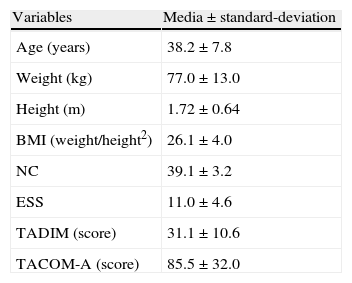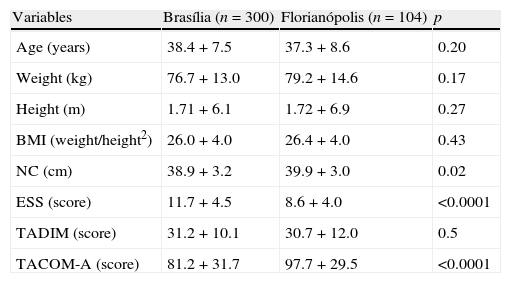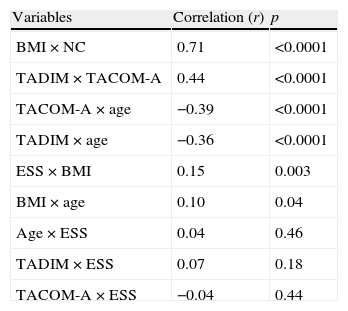Brazil is one of the world leaders in traffic accidents. The present article studied the excessive daytime sleepiness of public transport drivers in two Brazilian's capitals and their level of attention. A descriptive transversal study of a convenient sample was conducted. For the evaluation the following were used: anthropometric variables, a Sleep Questionnaire, Epworth Scale of Sonolency (ESS), Diffused Attention Test (TADIM), and Concentrated Attention Test (TACOM-A). 300 drivers from Brasilia and 104 from Florianopolis were evaluated. The majority of the individuals were overweight and presented somnolence. The neck circumference was smaller in Brasília, where the drivers were also more sleepy and presented worst attention on TACOM-A. The analysis of correlation was significant between attention tests and age and between BMI and ESS. Factors such as differences in work journeys as well as differences between the traffic in these two cities may be associated to our findings. We concluded that sleepiness is a common factor of risk between professional bus drivers and that was correlated with BMI, as well as the attention was correlated with age.
O Brasil é um dos líderes mundiais em acidentes de trânsito. O presente artigo estudou a sonolência diurna excessiva de motoristas de transporte público de duas capitais brasileiras, bem como seus níveis de atenção. O presente estudo foi do tipo descritivo transversal, com amostra de conveniência. Para avaliação foram utilizados: variáveis antropométricas, um Questionário de Sono, a Escala de Sonolência de Epworth (ESS), o Teste de Atenção Difusa (TADIM) e o Teste de Atenção Concentrada (TACOM-A). Foram avaliados 300 motoristas das cidades de Brasília e Florianópolis. A maior parte dos indivíduos apresentava-se com sobrepeso e sonolenta. A circunferência do pescoço foi menor em Brasília, onde os motoristas também eram mais sonolentos e apresentaram pior desempenho no TACOM-A. A análise de correlação foi significativa entre os testes de atenção e idade e entre IMC e ESS. Fatores como diferenças nas jornadas de trabalho bem como diferenças no tráfego entre as duas cidades podem estar associados aos nossos achados. Concluímos que a sonolência é fator de risco comum entre motoristas profissionais de ônibus e esta se correlacionou com o IMC, bem como a atenção também se correlacionou com a idade.
Although Brazil has developed a new traffic code, it continues to be one of the highest globally in terms of vehicular statistics accidents,1 with a great number of deaths and injuries.2 The analysis of official data reveals only partially the number of traffic accidents (TA), due to the difficulty of registering all of them, considering that the traffic authorities are not always called, accident report is not always completed and the accident is not always recorded.3 By definition, an accident is the unintended result of a combination of unsafe causes, intentional or not, which translates into an emergency situation of risk and result in material, human, financial, psychological, physiological or social damages.4 Regarding the TA, professional drivers, and especially bus drivers, are the ones often involved in traffic accidents. We already know that the majority of TA are correlated to failures in taking decisions and the processing of information, which shows up the importance of the human factor in this context and also the lack of attention of drivers.5 The present study proposes to measure the sleepiness of urban public transportation drivers of two Brazilian capitals, quantify their level of attention and their results in tests of attention as well as correlating the studied variables.
MethodsThis is an observational, descriptive, cross-sectional study, of professional urban bus drivers in the cities of Brasília and Florianopolis, the capitals of the states of Distrito Federal and Santa Catarina, respectively, carried out from August to October 2008. Based on National Health Council of the Health Ministry resolution (CNS/MS) 196/96, the Research Ethics Committee Coordination of Medicine Faculty of University of Brasilia approved ad referendum this project as to their ethical aspects. The public urban transportation companies were invited to provide some of their drivers to attend a lecture on the theme of “Excessive Sleepiness and Traffic Accidents”, using four evaluation instruments. The two capitals have the same number of urban public transportation companies and about the same number of drivers. Brasilia was chosen given for the author's convenience, and Florianopolis, because it has similar characteristics to the federal capital. Those who met the inclusion criteria, that is a regular driver of urban public transport, should be available to attend the presentation and evaluation, and accept, by written and signed consent, participation in this protocol. Occasional drivers were excluded, as well as those who were not registered members of staff.
Subsequent to the aforementioned lecture, the drivers were evaluated by the following four steps: identification of participants with the measurement of anthropometric variables (weight, height, BMI and neck circumference-NC); the application of the Sleep Questionnaire which consisted of a history of snoring, or feeling of asphyxia, or suffocation and/or apnea, as well as lifestyle habits that may affect sleep (alcoholism, smoking, use of stimulants: tea, coffee, soft drinks derived from cola, chocolate and pharmacological stimulants); co-morbidities already known (such as hypertension, heart disease, myocardial infarction, stroke, diabetes, COPD, bronchial asthma, allergic rhinitis, fibromyalgia, epilepsy, depression, anxiety and panic disorder); and the use of any medication that could alter or influence sleep.6 In addition, the Epworth Sleepiness Scale (ESS), the diffuse concentration (TADIM) and focused tests (TACOM-A) were used. To analyze possible differences among drivers regarding the clinical predictors of the severity of the sleep apnea obstructive syndrome, the degree of excessive daytime sleepiness and the TA, the variables employed were those already mentioned, and the cutoff points were: BMI <30 and ≥30kg/m2; NC <42 and ≥42cm7; ESS <10 and ≥10 points; intense snoring (yes or no); reported traffic accidents (yes or no); degree of diffused attention on TADIM (lower zone or lower average); level of focused attention on the TACOM-A (lower zone or lower average). The TADIM relating to the driver's educational levels was established in B category, which means from fifth to eighth grade of schooling. The lower zone refers to the range of 15–27 points and the lower average zone, of 28–31 points; as the level measured by the TACOM-A, according to the schooling mentioned above, the lower zone is the range of 31–48 points and the lower average zone is the range of 52–61 points.8
The normal distribution of data was verified by the Kolmogorov–Smirnov test and the comparison was made by the nonparametric Mann–Whitney test. For the analysis of correlation the nonparametric Spearman test was used. All tests were performed by the statistical software SPSS version 13.2 (Chicago, IL, USA) and the level of significance was 5%.
ResultsSeven companies were contacted in each city. 404 drivers of urban public transportation were evaluated, of which 300 were from Brasília; they were all males. The individuals presented overweight, sleepiness and slightly inattentive in terms of diffused attention, according to the cutoff points established, as described in Table 1.
Anthropometric variables, values of ESS and of diffused concentration and focused tests of all sample (n=404).
| Variables | Media±standard-deviation |
| Age (years) | 38.2±7.8 |
| Weight (kg) | 77.0±13.0 |
| Height (m) | 1.72±0.64 |
| BMI (weight/height2) | 26.1±4.0 |
| NC | 39.1±3.2 |
| ESS | 11.0±4.6 |
| TADIM (score) | 31.1±10.6 |
| TACOM-A (score) | 85.5±32.0 |
NC: neck circumference; ESS: Epworth Sleepiness Scale; TADIM: diffused concentration test; TACOM-A: focused concentration test
Comparing the drivers of the cities examined, the Florianopolis drivers had significantly higher neck circumference, lower level of sleepiness and better performance in focused attention, as the data shown in Table 2.
Description and comparison of anthropometric variables, ESS and diffused concentration tests and focused concentration tests split by city studied.
| Variables | Brasília (n=300) | Florianópolis (n=104) | p |
| Age (years) | 38.4+7.5 | 37.3+8.6 | 0.20 |
| Weight (kg) | 76.7+13.0 | 79.2+14.6 | 0.17 |
| Height (m) | 1.71+6.1 | 1.72+6.9 | 0.27 |
| BMI (weight/height2) | 26.0+4.0 | 26.4+4.0 | 0.43 |
| NC (cm) | 38.9+3.2 | 39.9+3.0 | 0.02 |
| ESS (score) | 11.7+4.5 | 8.6+4.0 | <0.0001 |
| TADIM (score) | 31.2+10.1 | 30.7+12.0 | 0.5 |
| TACOM-A (score) | 81.2+31.7 | 97.7+29.5 | <0.0001 |
NC: neck circumference; ESS: Epworth Sleepiness Scale; TADIM: diffused concentration test; TACOM-A: focused concentration test
The correlation analysis in whole sample showed significant correlations between BMI and NC (r=0.71, p<0.001), between TADIM and TACOM-A (r=0.44, p<0.001), between TADIM and age (r=−0.36, p<0.001), between TACOM-A and age (r=−0.39, p<0.001), between BMI and ESS (r=0.15, p=0.003) and between BMI and age (r=0.10, p=0.04), as reported in Table 3.
Analysis of correlation and level of significance between the studied variables.
| Variables | Correlation (r) | p |
| BMI×NC | 0.71 | <0.0001 |
| TADIM×TACOM-A | 0.44 | <0.0001 |
| TACOM-A×age | −0.39 | <0.0001 |
| TADIM×age | −0.36 | <0.0001 |
| ESS×BMI | 0.15 | 0.003 |
| BMI×age | 0.10 | 0.04 |
| Age×ESS | 0.04 | 0.46 |
| TADIM×ESS | 0.07 | 0.18 |
| TACOM-A×ESS | −0.04 | 0.44 |
NC: neck circumference; ESS: Epworth Sleepiness Scale, TADIM: diffused concentration test; TACOM-A: focused concentration test
Economic growth has not only brought an increased number of jobs, but also many of these employees started to work on night shifts, with negative repercussions on the individual and collective health. Employees, without a fixed rota, are subject to changes and even an inversion of the normal sleep-wake cycle.9 These changes have many detrimental effects, such as unhealthy eating habits, excessive daytime sleepiness, decreased reflexes and attention.10 The eating habits change stems from the fact of being awake and working in a period that earlier was restricted to the rest and sleep. For decades, the consensus has been that the frequency of meals can affect body weight, since the metabolic efficiency of food differs according to the time that is ingested.11 So, as expected, this leads to a larger intake of calories12,13 causing weight gain.14
The professional driver is exposed to numerous risks at work, which makes them more vulnerable to accidents at work.15 Some studies have demonstrated the effect of excessive daytime sleepiness related with impaired attention, memory, reaction time, problem-solving16 and cognition, which increase the risk of accidents.5 Obtaining a driver's license involves a psychological assessment and, as one would expect, attention is one of the most important cognitive factors in driving behavior.17 On the other hand, it is known that sleep deprivation is responsible for approximately 15–20% of all vehicle accidents in the world and it is the largest identifiable cause of transport accidents.18 It is already known that a bus driver's sleep is short and fragmented, and when it occurs during the day there is a large sleep debt and fatigue. Thus, the drivers do not have restful sleep, even after a 7-h sleep.19 In fact, there is a report showing that the majority of TA are related to failures in taking decisions and processing information,20 in which excessive somnolence may play an important role.
The work of professional bus drivers in Brazil is characterized by routine, with poor conditions, long journeys, sleepless nights, inappropriate eating habits and urban violence.21 Delays and hold-ups driving can also be seen as stress generators and they cause drivers to pay less attention to what is happening around them, which can lead to undesirable behaviors and reduced speed of reaction to specific driving demands.2 In a study of bus drivers in Brasilia, it was observed that there were worries about meeting schedules, and this can generate inappropriate behavior in traffic, such as stopping away from the bus stop, braking abruptly and driving over the speed limit, factors that can affect the performance of the drivers.22
There is reference in the literature1 which lists 100 cities in Brazil with the highest death rates from TA, based on the numbers of deaths between 2005 and 2007. The comparison between the states shows that Santa Catarina23 has the highest average rate of deaths per 100,000 inhabitants (33.1). On the other hand, the Distrito Federal, in the same period, presented the average rate of 21.6 deaths per 100 thousand inhabitants.24
The sample studied here was characterized by overweight, sleepiness and being scattered in terms of diffused attention, despite their youth, according to the cutoff points established. We must say that although there was a significant number of participants from the two capitals, they were not uniform, and it is worth noting that only one Florianopolis company agreed to participate in this study, and four in Brasília. Thus, 68% of drivers evaluated in Brasilia and 41% of drivers in Florianopolis had excessive daytime sleepiness. The whole sample presented a positive correlation between age and BMI, and between ESS and BMI, as already foreseen in a report in the literature.25 This may have been due to the fact that the sample was all overweight, and by the fact that the population was young. Interestingly, the comparison of NC between the capitals showed that the Florianopolis drivers had higher NC; however, in neither of the capitals was the average found considered high enough to be a risk factor, according to the cutoff point established. Perhaps, the fact that NC has presented an opposite behavior to that expected might be attributed to the smaller number of participants in Florianópolis.
As it was a young population, age had a negative correlation on the focused and diffused attention tests. On the TACOM-A, the drivers of both capitals had a satisfactory performance, but in Florianopolis, they showed statistically significantly higher levels of attention than the Brasilia professionals. Although no action was taken to identify an association between variables, we also noted that the Florianopolis drivers showed also statistically significantly less sleepiness than Brasilia drivers. The differences between the two capitals in the TACOM-A and ESS tests can also be assigned to different work schedules between the two cities. The drivers of Brasília have a 6-h working day and the rota is drawn up in such a way that drivers work two shifts in one day, interspersed with periods of up to 6h of rest, with four free weekdays a month, and one Sunday off a month. This fragmented work schedule means Brasilia drivers have to rest inside their buses, since there are no rest areas in the company garages. On the other hand in Florianopolis, the working day is approximately 7h and forty minutes, and they have an hour to rest. In Florianopolis it is possible to do 2-h overtime in a working day as long as there is weekly clearance, and it is also important to emphasize that the rota in this city changes every six months. The fact that there is a fixed daytime rota, although subject to possible changes in schedules, may be a factor that minimizes the presence of sleepiness in Florianopolis’ drivers. It seems that having continuity in timetables may improve the use of free time, and making more effective used of the rest periods. Added to this fact, Brasilia has potentially major traffic jams during rush hours, which can also influence the excessive sleepiness in these drivers. By this turn, Florianopolis traffic varies according to the time of year, with a significant increase only in the summer holidays. As this study was carried out mainly during spring, there were probably far fewer traffic jams in Florianopolis than during the peak period. As a final point it is worth noting that with the basic knowledge about sleep and its disorders, the companies could take simple and low cost measures to improve the quality of life of the bus drivers, leading to safe driving and also leading to an improvement in services offered,26 with potentially important impact on public health.
ConclusionsThe professional urban bus drivers of Brasília had a greater level of sleepiness and had worst scores on attention tests, compared with the Florianópolis drivers.
The whole sample showed that the sleepiness is correlated with the BMI as well as the attention tests being correlated with age.
Ethical disclosuresProtection of human and animal subjectsThe authors declare that no experiments were performed on humans or animals for this investigation.
Confidentiality of dataThe authors declare that they have followed the protocols of their work center on the publication of patient data and that all the patients included in the study have received sufficient information and have given their informed consent in writing to participate in that study.
Right to privacy and informed consentThe authors have obtained the informed consent of the patients and/or subjects mentioned in the article. The author for correspondence must be in possession of this document.
Conflicts of interestThe authors have no conflicts of interest to declare.
Dante Santos Brazil, Eduardo Gaio and Carlos Alberto de Assis Viegas are Brazilian government officials at the University of Brasilia.
Please cite this article as: Brasil Santos D, et al. Sonolência diurna e atenção em motoristas de ónibus urbanos de 2 capitais do Brasil. Rev Port Pneumol. 2013. http://dx.doi.org/10.1016/j.rppneu.2013.01.001









